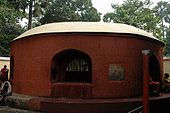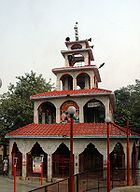
Agam Kuan
Encyclopedia
Agam Kuan, which means "unfathomable well", is said to date back to the period of Maurya emperor
, Ashoka
. The well is located east of Patna
, Bihar
state
, India
.
 Agam Kuan is 105' deep, circular in plan, with a diameter extending over 20'2". The well is brick-encased in the upper half of its depth (down to 44') and thereafter, secured by a series of wooden rings. The surface structure, which now covers the well and forms its most distinctive feature, has eight arched windows.
Agam Kuan is 105' deep, circular in plan, with a diameter extending over 20'2". The well is brick-encased in the upper half of its depth (down to 44') and thereafter, secured by a series of wooden rings. The surface structure, which now covers the well and forms its most distinctive feature, has eight arched windows.
 Next to the Agam Kuan lies the Shitala Devi temple, dedicated to Shitala Devi
Next to the Agam Kuan lies the Shitala Devi temple, dedicated to Shitala Devi
, which houses the pindas of the 'Saptamatrikas' (the seven mother goddesses). The temple is widely revered for its potency in curing smallpox
and chicken pox, as with all Shitala Devi temples, and is also visited by devotees for wish fulfillment.
The site also has several ancient and medieval sculptures, out of these at least one as reported by A. Cunningham, who visited the site, 1879-80, was of the Yaksha
of the Mauryan art-affiliation , though the whereabouts of this sculpture are not known now.
 During the 1890s, the British explorer, Laurence Waddell, while exploring the ruins of Patliputra
During the 1890s, the British explorer, Laurence Waddell, while exploring the ruins of Patliputra
, identified Agam Kuan as the legendary well built by Ashoka for torturing people, a practice reported by Chinese travellers (most probably Fa Hien) of the 5th and 7th centuries A.D.
Another popular legend states that this was the well where Ashoka threw ninety-nine of his elder brothers after killing them to obtain the throne of the Mauryan Empire.
The site is also connected with several Jain legends, the most famous of them being that of a Jain monk Sudarshana who, when thrown into the well by a king named Chand, floated to the surface and was found seated on a lotus.
The well's is still considered auspicious and a site for many religious ceremonies, especially Hindu
weddings
Maurya Empire
The Maurya Empire was a geographically extensive Iron Age historical power in ancient India, ruled by the Mauryan dynasty from 321 to 185 BC...
, Ashoka
Ashoka
Ashok Maurya or Ashoka , popularly known as Ashoka the Great, was an Indian emperor of the Maurya Dynasty who ruled almost all of the Indian subcontinent from ca. 269 BC to 232 BC. One of India's greatest emperors, Ashoka reigned over most of present-day India after a number of military conquests...
. The well is located east of Patna
Patna
Paṭnā , is the capital of the Indian state of Bihar and the second largest city in Eastern India . Patna is one of the oldest continuously inhabited places in the world...
, Bihar
Bihar
Bihar is a state in eastern India. It is the 12th largest state in terms of geographical size at and 3rd largest by population. Almost 58% of Biharis are below the age of 25, which is the highest proportion in India....
state
States and territories of India
India is a federal union of states comprising twenty-eight states and seven union territories. The states and territories are further subdivided into districts and so on.-List of states and territories:...
, India
India
India , officially the Republic of India , is a country in South Asia. It is the seventh-largest country by geographical area, the second-most populous country with over 1.2 billion people, and the most populous democracy in the world...
.
The architecture

Shitala Devi temple

Shitala Devi
Shitala , also called Sitala , is a Hindu goddess widely worshipped in North India, West Bengal, Nepal, Bangladesh and Pakistan as the pox-goddess. Shitala Devi literally means the cold Goddess.-Name and variants:...
, which houses the pindas of the 'Saptamatrikas' (the seven mother goddesses). The temple is widely revered for its potency in curing smallpox
Smallpox
Smallpox was an infectious disease unique to humans, caused by either of two virus variants, Variola major and Variola minor. The disease is also known by the Latin names Variola or Variola vera, which is a derivative of the Latin varius, meaning "spotted", or varus, meaning "pimple"...
and chicken pox, as with all Shitala Devi temples, and is also visited by devotees for wish fulfillment.
The site also has several ancient and medieval sculptures, out of these at least one as reported by A. Cunningham, who visited the site, 1879-80, was of the Yaksha
Yaksha
Yaksha is the name of a broad class of nature-spirits, usually benevolent, who are caretakers of the natural treasures hidden in the earth and tree roots. They appear in Hindu, Jain and Buddhist mythology. The feminine form of the word is ' or Yakshini .In Hindu, Jain, and Buddhist mythology,...
of the Mauryan art-affiliation , though the whereabouts of this sculpture are not known now.
Legends

Patliputra
Pāṭaliputra , modern-day Patna, was a city in ancient India, originally built by Ajatashatru in 490 BC as a small fort near the River Ganges, and later the capital of the ancient Mahājanapadas kingdom of Magadha....
, identified Agam Kuan as the legendary well built by Ashoka for torturing people, a practice reported by Chinese travellers (most probably Fa Hien) of the 5th and 7th centuries A.D.
Another popular legend states that this was the well where Ashoka threw ninety-nine of his elder brothers after killing them to obtain the throne of the Mauryan Empire.
The site is also connected with several Jain legends, the most famous of them being that of a Jain monk Sudarshana who, when thrown into the well by a king named Chand, floated to the surface and was found seated on a lotus.
The well's is still considered auspicious and a site for many religious ceremonies, especially Hindu
Hindu
Hindu refers to an identity associated with the philosophical, religious and cultural systems that are indigenous to the Indian subcontinent. As used in the Constitution of India, the word "Hindu" is also attributed to all persons professing any Indian religion...
weddings

